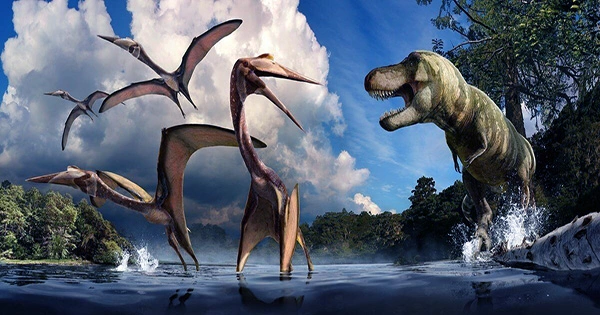Brightly colorful feathers on a preserved pterosaur headcrest resembled the most extravagant current birds. The discovery has the potential to change how we think about coloration in pterosaurs and dinosaurs alike. While palaeontologists and palaeontology lovers have argued whether dinosaurs had feathers and what they were employed for, the fanciest cretaceous plumage may have belonged to the pterosaurs, their fellow reptiles.
The pterosaur Tupandactylus imperator was known for its massive headcrest. Dr. Aude Cincotta of University College Cork and colleagues spotted several small feathers on the underside of the crest of a 115 million-year-old specimen from the Crato formation in north-eastern Brazil. They published a paper in Nature announcing their discovery. Cincotta stated in a statement, “We didn’t expect to see this at all.” “Paleontologists have debated whether pterosaurs possessed feathers for decades. The feathers in our specimen put an end to the controversy once and for all, as they are plainly branched all the way down their length, much like modern birds.”
Short wiry hair-like fibers and fluffy branching feathers that would make modern birds happy are the two types of feathers available. Years ago, it was recognized that some pterosaurs had the fibers, which are properly called pycnofibres, but more sophisticated forms had never been proved. Feathers on other parts of the body may be for warmth or aerodynamics, but their arrangement on the headcrest suggests signaling — either to attract mates or to keep rivals at bay. If that’s the case, vivid colors may help them stand out, so the researchers began seeking for melanosomes, or granules of melanin, the most essential pigment in contemporary animals.
Despite the color being gone after a hundred million years below, the team was still able to detect that various feather kinds had distinct shaped melanosomes. “Feather color is significantly connected to melanosome form in today’s birds,” stated co-author Professor Maria McNamara. “Because various pterosaur feather types had diverse melanosome forms, these creatures must have possessed the genetic equipment to alter their feather hues.” This trait is necessary for color patterning, demonstrating that coloring was an important aspect of even the earliest feathers.” Unfortunately, we don’t know what colors Tupandactylus was.
There are over 100 distinct pterosaur species, so we’ll need a lot more fossils with this level of preservation to figure out if they all had feathers, let alone various colored ones. However, scientists believe that feathers developed just once on Earth before dinosaurs and pterosaurs split during the Triassic period. In which scenario, any non-feathered pterosaur, or dinosaur for that matter, would have lost them sometime along the way, implying that they were the rule rather than the exception, given their many purposes.
Even creatures that did not use feathers for communication or flying may have benefited from downy insulation over time. Insulation is beneficial to organisms that generate their own body heat rather than those that rely on the environment for heat, such as contemporary reptiles. As a result, this research implies that both pterosaurs and dinosaurs were warm-blooded.
Fossils from impoverished nations, like historical relics, frequently end up in wealthier institutions with the capacity to purchase and examine them. The T. imperator specimen, on the other hand, was deemed so valuable by the experts that it should be regarded as part of Brazil’s natural heritage. They planned for it to be returned to its homeland with the support of a private donor, presumably creating a precedent for such significant finds.















